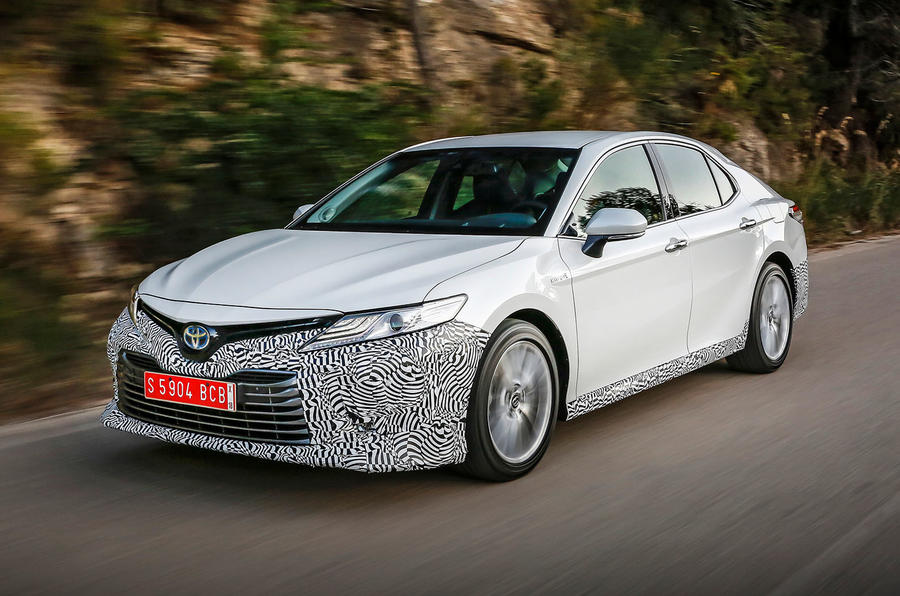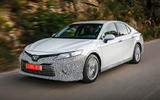What is it?
This is the European version of what you get if you order an online cab from Los Angeles airport. The Toyota Camry is the most successful big saloon car in the world, and it was a nameplate you could get in the UK until 2004, when it was canned because the European big saloon market was going big on diesel and the Camry didn’t offer one.
Now? The big saloon market is going nowhere particularly fast, and it's particularly ordinary for the Avensis. So, the Avensis is being dropped and the Camry, available in Europe only with a hybrid powertrain, is being reintroduced.
The internal combustion component of its powertrain is a 2.5-litre four-cylinder unit with some fancy straight inlet ports (making the fuel swirl and therefore burn more efficiently) and both port and direct injection – each has different advantages at different revs and throttle openings. The overall thermal efficiency is 41%, says Toyota, which is rubbish compared to an electric motor’s 90-odd per cent but good for a petrol unit.
It drives the front wheels through Toyota’s hybrid system, which uses the drive engine, a starter motor and a drive motor (motor generators 1 and 2 in Toyota speak) with a planetary gearset linking them. This allows the drive motor and engine to run at any speed, regardless of the wheel speed, because the starter-generator will be there to make up the difference.
It’s a brilliantly simple concept with, presumably, brilliantly complicated control software, which is why Toyota engineers get the hump if someone calls it a continuously variable transmission. Combined, maximum power is 215bhp, with fuel consumption likely to be confirmed at an official 61mpg (although we saw 40+ mpg on the trip computer).
All of those drive shenanigans aside, it’d also be slightly disingenuous to say Camry replaces Avensis, because, as befits a car they sell more than 400,000 of per year in the US alone, it's bigger. At 4.89m long, it’s between Ford Mondeo and BMW 5 Series in length, while at 1840mm wide across the doors, it's just narrower than a Mondeo, but at the top end of the D-segment either way.
It's based on Toyota’s recently introduced TNGA (Toyota New Global Architecture) platform, whose advantages, Toyota says, include a low engine location, which allows a low dashboard, thus lowering (improving) the centre of gravity. There’s also lots of high-strength steel in the body, apparently meaning the A-pillars are thin and the body stiff, while the battery for the hybrid system fits beneath the back seats, as does the fuel tank. And the rear suspension is by fancy double wishbones, doncha know.
Not that it’ll matter, because big saloons are big and boring to drive. But hark! Here’s Masato Katsumata, Toyota’s global chief engineer for the Camry. His first gig in the company was as a handling engineer, while he’s also been senior vice president for R&D in Europe. And he owns an early Celica.
“We want to create emotion in a hybrid system,” he says. The rigid body, particularly where the steering is mounted, “contributes to realising dynamic performance”. This, it’s fair to say, would be a bit of a departure for the Camry, no? But European models get different dampers from US cars, plus bespoke tuning of damping, springing, anti-roll bars and steering. So let’s see.





































Join the debate
Add your comment
I’m currently driving a 2017
I should add that the ride quality of the 2017 model I’m driving is poor. My 5-series has a far superior ride quality even on 19” wheels compared to the Camry on 17” wheels. The Camry I’m using is a poverty spec car, a GL, so it does without most mod cons that I have even on my old 2003 cars, such as rain-sensing wipers. In summary then the Camry feels very old, is very basic and is certainly not in any way luxurious, but as others have said it will no doubt out-last most other cars on the planet, because, unlike German cars, there isn’t much on it to go wrong. It’s ok at the right price but unless the 2018 model is significantly better, £30k is simply too much.
I’m currently driving a 2017
I’m currently driving a 2017 Camry around New Zealand and all I can say is that it’s not no £30k car, so unless the 2018 model is significantly better then it won’t sell well in the UK. It feels incredibly cheap compared to my 2017 5-series in so many ways. The door cards are shiny black plastic, there is no soft rest for the driver’s knees when cornering sharply through mountainous terrain, the non-hybrid 2.5 engine takes a long time to pick up and is very thrashy at high revs. The economy has been low ‘30’s mpg on long drives with a maximum speed of 60mph. I personally find the driving position woeful with my right knee sitting between a hard door handle and the ignition key which I don’t want to knock ( I’m 6ft). The boot is big and there are acres of leg room in the rear so it will be great as a taxi, but it’s no luxury cruiser. Prior to renting it I had thought that I might be impressed with it, and I thought I might be left with the impression that premium German cars were not worth the premium. At £20k (it’s cost in New Zealand NZ$39k) it’s probably OK, but at £30k it will be too close to premium saloons and it certainly isn’t one of the those.
no nonsense
Did about 250000 in one of these in the early noughties. There was nothing like it really, huge wallowy car that ate miles and never ever let us down. You could lie down (6ft tall) in the boot and something that isn't often mentioned is just how well put together the interior was, particularly the leather upholstery. Loads of car for the money and not just another generic 2 litre german diesel saloon. If this is like the old one, ill have one